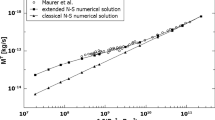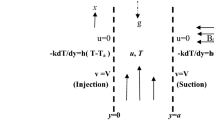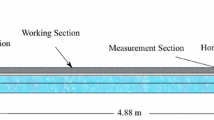Abstract
Despite the enormous scientific and technological importance of micro-channel gas flows, the understanding of these flows, by classical fluid mechanics, remains incomplete including the prediction of flow rates. In this paper, we revisit the problem of micro-channel compressible gas flows and show that the axial diffusion of mass engendered by the density (pressure) gradient becomes increasingly significant with increased Knudsen number compared to the pressure driven convection. The present theoretical treatment is based on a recently proposed modification (Durst et al. in Proceeding of the international symposium on turbulence, heat and mass transfer, Dubrovnik, 3–18 September, pp 25–29, 2006) of the Navier–Stokes equations that include the diffusion of mass caused by the density and temperature gradients. The theoretical predictions using the modified Navier–Stokes equations are found to be in good agreement with the available experimental data spanning the continuum, transition and free-molecular (Knudsen) flow regimes, without invoking the concept of Maxwellian wall-slip boundary condition. The simple theory also results in excellent agreement with the results of linearized Boltzmann equations and Direct Simulation Monte Carlo (DSMC) method. Finally, the theory explains the Knudsen minimum and suggests the design of future micro-channel flow experiments and their employment to complete the present days understanding of micro-channel flows.











Similar content being viewed by others
References
Agrawal A, Djenidi L, Antonia RA (2005) Simulation of gas flow in micro-channels with a sudden expansion or contraction. J Fluid Mech 530:135–144
Agrawal A, Agrawal A (2006) Three-dimensional simulation of gas flow in different aspect ratio microducts. Phys Fluids 18(103604):1–11
Arkilic EB, Schmidt MA, Breuer KS (1994) Gaseous flow in micro-channels. In: Application of microfabrication, ASME winter annual meetings, Chicago, November, pp 57–65
Arkilic EB, Schmidt MA, Breuer KS (1997) Gaseous slip flow in long microchannels. J Micro Electro Mech Syst 6(2):167–178
Beskok A, Karniadakis GE (1999) A model for flows in channels, pipes, and ducts at micro and nano scales. Microscale Thermophys Eng 3:43–77
Bielenberg JR, Brenner H (2006) A continuum model of thermal transpiration. J Fluid Mech 546:1–23
Brenner H (2005) Navier–Stokes revisited. Physica A 349:60–132
Brenner H (2006) Fluid mechanics revisited. Physica A 370:190–224
Cercignani C, Daneri A (1963) Flow of a rarefied gas between two parallel plates. J Appl Phys 34:3509–3513
Cercignani C, Lampis M, Lorenzani S (2004) Variational approach to gas flows in microchannels. Phys Fluids 16:3426–3437
Churchill SW, Usagi R (1972) A general expression for the correlation of rates of transfer and other phenomena. AIChE J 18(6):1121–1128
Colin S (2005) Rarefaction and compressibility effects on steady and transient gas flow in microchannels. Microfluid Nanofluidics 1(3):268–279
Deissler RG (1964) An analysis of second-order slip flow and temperature- jump boundary conditions for rarefied gases. Int J Heat Mass Transf 7:681–694
Dong W (1956) University of California Report UCRL-3353
Dongari N, Agrawal A, Agrawal A (2007) Analytical solution of gaseous slip flow in long microchannels. Int J Heat Mass Transf 50:3411–3421
Durst F, Ray S, Ünsal B, Bayoumi OA (2005) The development lengths of laminar pipe and channel flows. J Fluids Eng 127(6):1154–1160
Durst F, Gomes J, Sambasivam R (2006) Thermofluiddynamics: Do we solve the right kind of equations? In: Proceeding of the international symposium on turbulence, heat and mass transfer, Dubrovnik, 3–18 September, pp 25–29
Gaede W (1913) Die Aussere Reibung der Gase. Ann Phys 41:289
Gad-el-Hak M (1999) The fluid mechanics of microdevices–the Freeman scholar lecture. J Fluids Eng 121:5–33
Greenshields C, Reese JM (2007) The structure of shock waves as a test of Brenner’s modifications to the Navier–Stokes equations. J Fluid Mech 580:407–429
Hosticka B et al (1998) Gas flow through aerogels. J Non-Crystalline Solids 225(1):293–297
Huang WD, Bogy DB, Garcia AL (1997) Three dimensional direct simulation Monte Carlo method for slider air bearings. Phys Fluids 9(6):1764–1769
Karniadakis GE, Beskok A, Aluru N (2005) Microflows–fundamentals and simulations. Springer, New York
Kennard EH (1938) Kinetic theory of gases with an introduction to statistical mechanics. Allied Pacific, Bombay
Knudsen M (1909) Die Gesetze der Molekularströmung und der inneren Reibungsströmung der Gase durch Röhren. Ann Phys 28:75–130
Loyalka S, Hamoodi S (1990) Poiseuille flow of a rarefied gas in a cylindrical tube: solution of a linearized Boltzmann equation. Phys Fluids A 2(11):2061–2065
Malek K, Coppens MO (2003) Knudsen self- and Fickian diffusion in rough nanoporous media. J Chem Phys 119(5):2801–2811
Maurer J, Tabeling P, Joseph P, Willaime H (2003) Second-order slip laws in micro-channels for helium and nitrogen. Phys Fluids 15(9):2613–2621
Maxwell JC (1879) On stresses in rarefied gases arising from inequalities of temperature. Philos Trans R Soc Part 1 170:231–256
Mehregany M, Nagarkar P, Senturia S, Lang JH (1990) Operation of microfabricated harmonic and ordinary side drive motor. In: IEEE micro electro mechanical system workshop, pp 344–352
Mo G, Rosenberger F (1990) Molecular dynamics simulation of flow in a two dimensional channel with atomically rough walls. Phys Rev A 42:4688–4692
Ohwada T, Sone Y, Aoki K (1989) Numerical analysis of the Poiseuille and thermal transpiration flows between two parallel plates on the basis of the Boltzmann equation for hard sphere molecules. Phys Fluids A 1(12):2042–2049
Pan LS, Liu GR, Lam KY (1999) Determination of slip coefficient for rarefied gas flows using direct simulation Monte Carlo. J Micromech Microeng 9:89–96
Richardson S (1973) On the no-slip boundary condition. J Fluid Mech 59:707–719
Schamberg R (1947) The fundamental differential equations and the boundary conditions for high speed slip-flow and their applications to specific problems, PhD Thesis, California Institute of Technology
Sone Y (1989) Analytical and numerical studies of rarefied gas and their ghost effect on the behavior of a gas in the continuum limit. Annu Rev Fluid Mech 32:779–811
Sreekanth AK (1969) Slip flow through long circular tubes. In: Trilling L, Wachman HY (eds) Proceedings of the sixth international symposium on Rarefied gas dynamics, Academic Press, London, pp 667–680
Tai YC, Fan LS, Muller RS (1989) IC-processed micro-motors: design, technology, and testing. In: IEEE micro electro mechanical system workshop, vol 1–6. pp 20–22
Tison SA (1993) Experimental data and theoretical modeling of gas flows through metal capillary leaks. Vacuum 44:1171–1175
Trimmer W (1997) Micromechanics and MEMS, Classic and seminar papers to 1990, IEEE Order Number PC4390, ISBN 0-7803-1085-3
Acknowledgments
The author (N. Dongari) acknowledges the research grant provided by Lehrstuhl für Prozessmaschinen und Anlagentechnik (IPAT), Friedrich Alexander Universität Erlangen-Nürnberg. The co-author (F. Durst) acknowledges the financial support by the DFG (Deutsche Forschungsgemeinschaft), Germany, within the project DU101/82-1. Further support was received from FMP Technology GmbH. The support of the Alexander von Humboldt Foundation (A. Sharma) in the form of a Friedrich Wilhelm Bessel award is gratefully acknowledged. The authors are grateful to Prof. Amit Agrawal of IIT Bombay, Mr. Karthik of IIT Guwahati and Ms. Amra Mekic of University of Sarajevo for discussions.
Author information
Authors and Affiliations
Corresponding author
Appendix: Treatments of molecular diffusion in ideal gas flows
Appendix: Treatments of molecular diffusion in ideal gas flows
When diffusion in ideal gas flows is treated in such a way that the conventional Navier–Stokes equations are derived, the following is assumed:
This readily suggests that no density and temperature gradients (or corresponding pressure gradients) are present in the flow field. Hence this assumption contradicts Fourier’s law of diffusive heat transport, usually given as
The contradiction arises because every temperature gradient is related to mass diffusion. The derivations for \( \dot{m}_{i}^{D} \) based on self-diffusion yield, see Durst et al. (2006):
With this expression for \( \dot{m}_{i}^{D}, \) the diffusive heat transport results as
The corresponding momentum transport for τ ij , the molecular momentum transport, reads as follows:
This expression can be rewritten to yield
For the considerations in this paper, the above diffusive transport terms are of importance for the special case of T = constant. Because of the small Mach number, flows treated in micro-channel fluid mechanics are isothermal. Hence we can write, using the equation of state for ideal gases:
Hence, one can derive for isothermal flow:
It is important to note that in \( \dot{m}_{i}^{D} \) derived by Brenner (2005) is identical with \( \dot{m}_{i}^{D} \) derived by Durst et al. (2006) for T = constant:
It can be shown that \( \alpha = \frac{\lambda }{{c_{p} }} = \left( {\rho D} \right) \) by Brenner (2005, 2006) is identical with (−ρD) by Durst et al. (2006), where \( D = \frac{1}{3}\bar{u}_{M} \lambda \) and hence, for T = constant. \( \dot{m}_{\text{Brenner}}^{D} = \dot{m}_{\text{Durst}}^{D} . \)
Rights and permissions
About this article
Cite this article
Dongari, N., Sharma, A. & Durst, F. Pressure-driven diffusive gas flows in micro-channels: from the Knudsen to the continuum regimes. Microfluid Nanofluid 6, 679–692 (2009). https://doi.org/10.1007/s10404-008-0344-y
Received:
Accepted:
Published:
Issue Date:
DOI: https://doi.org/10.1007/s10404-008-0344-y




